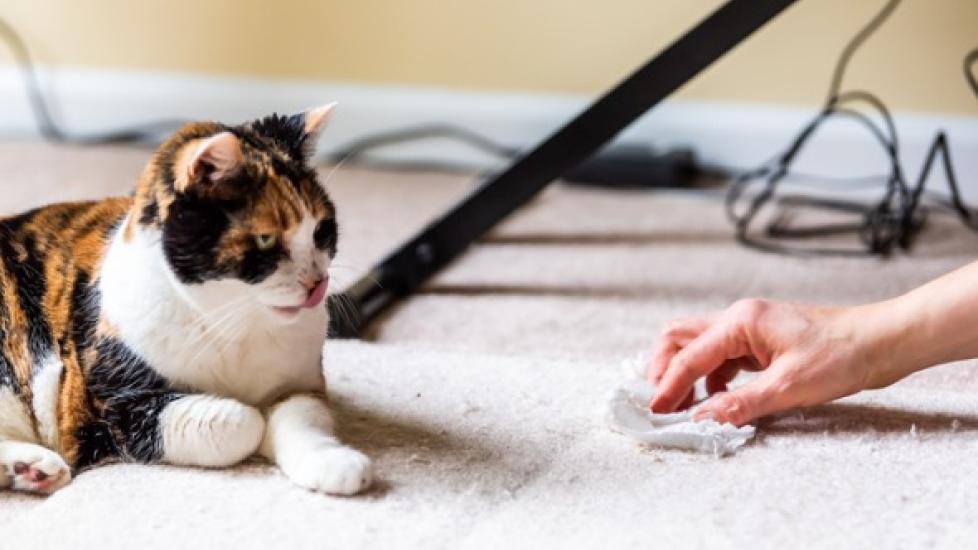Cat Regurgitation
Pet parents often use the words vomiting, throwing up, and regurgitation interchangeably. But regurgitation is actually different from vomiting, and it’s important to be able to spot the difference.
Regurgitation is defined as the action of bringing swallowed food up the esophagus and into the mouth. It’s usually an involuntary process. Cat regurgitation can be caused by many conditions or by a congenital (present from birth) defect of the esophagus. It is important to determine the cause of the regurgitation so you can work with your vet to alleviate the issue.
If you see lethargy, active vomiting, diarrhea, and/or weight loss along with regurgitation, contact your veterinarian immediately.
Cat Regurgitation vs. Vomiting
One difference between cat regurgitation and vomiting is that vomiting is usually an active process. This means that the stomach actively contracts to produce vomit.
With regurgitation, however, contents from the esophagus passively move up the esophagus and out of the mouth. Vomiting ejects contents of the stomach and upper small intestine, while regurgitation ejects contents of the esophagus.
Usually, regurgitation occurs just after eating, and the food expelled looks like it hasn’t been digested. Cats will often lower their head and eliminate food from the mouth easily, with no signs of nausea or upset stomach. This undigested food is often accompanied by slimy saliva or water and usually has a tubular shape, since it never entered the stomach.
Vomiting, on the other hand, involves forceful contraction of the abdominal muscles. Vomiting is often preempted by behavior such as drooling, lip-smacking, licking floors, increased gut sounds, or eating grass.
If regurgitation occurs less than once monthly and/or seems to coincide with eating quickly or overeating, then it’s not something to be overly concerned about.
However, more frequent regurgitation is something a veterinarian should look into, as it is likely caused by an underlying issue. Some of these issues are easier to resolve than others, and a speedy diagnosis allows for accurate treatment.
What Causes Cat Regurgitation?
Sometimes, your pet just eats too fast, but other times, there’s another cause behind regurgitation. Here are the most common reasons:
-
Overeating: If your cat tends to ingest more food than their stomach can hold, some of that food will remain in the esophagus and be expelled via the mouth right after eating.
- Eating too quickly: If your cat eats food too quickly, air is often ingested, causing the stomach to fill with air and food. Cats will regurgitate undigested food almost immediately. Sometimes when cats get anxious, such as when they are fed next to other cats, they innately feel a competitive nature to eat quickly and as much as possible. This leads to regurgitation.
- Drinking a large amount of water before or after eating can also cause regurgitation due to the stomach filling up with water.
- Esophageal issues such as decreased motility (either a muscular or neurologic issue of the autonomic nervous system) and narrowing (stricture) of the esophagus can lead to frequent regurgitation.
- Congenital malformations can cause regurgitation in cats. With patent ductus arteriosus (PDA), the vessels that normally close at birth remain open (or patent) and wrap around the esophagus. This causes a stricture that does not allow much food to pass by it.
- Diseases of the esophagus, including cancers, certain parasites (specifically Spirocerca lupi), benign growths, hiatal hernias, rabies virus, or foreign objects stuck in the throat can also cause cats to regurgitate.
How Do Vets Find the Cause of Cat Regurgitation?
Veterinarians can do several tests to seek the underlying cause of regurgitation in your cat. Non-invasive diagnostic testing includes bloodwork, x-rays of the neck, chest, and abdomen to assess the entire GI tract, and abdominal ultrasound.
Your vet may also need to do more invasive testing that requires general anesthesia. This would include a thorough oral examination to assess the back of the throat and upper gastrointestinal tract with an endoscopy. In this process, a flexible tube with a video camera is placed down the esophagus and into the stomach for direct visualization, and in some cases, to obtain tissue biopsies.
Sometimes, “swallow studies” are performed using contrast dye to assess with x-rays how food is moving through the gastrointestinal tract.
Cat Regurgitation Treatment and Prevention
Treatment of regurgitation depends on the underlying cause.
Eating Too Quickly
If your cat is stressed and tends to ingest their food too quickly, try to feed them away from other cats to reduce competition.
Special slow-feeder bowls can also help your cat slow down while eating. These work in some cases, but sometimes they can cause more air ingestion. So, it is important to monitor your cat’s eating habits when introducing one of these bowls.
Overeating
If they overeat, offer smaller amounts of food at a time. Moistening the food and choosing smaller kibble sizes have also been shown to lessen regurgitation in these instances.
Timed feeders can also be helpful to avoid overeating by offering smaller meals throughout the day instead of free-choice feeding.
Congenital Issues
Congenital issues such as PDA may require surgical correction. Other congenital disorders, such as neurologic or muscle issues, may require lifelong medications such as metoclopramide that help move food along the gastrointestinal tract.
Masses and Hiatal Hernias
Surgical removal of masses (both benign and malignant) and/or surgical correction of hiatal hernias may be considered if lifestyle changes do not help.
Sometimes, changing the diet is the only necessary treatment. Your veterinarian can help determine if you cat requires more fiber in their diet, or if hypoallergenic/novel protein diets may be helpful to lessen regurgitation.
Esophageal Issues
Elevating food and water bowls is recommended to allow gravity to more easily move food and water down the esophagus. Warming food and using room-temperature water can also help ease muscle contraction in the esophagus.
If your kitty is continuing to regurgitate after environmental changes, contact your veterinarian for an appointment where all diagnostic testing options can be considered.
Featured Image: iStock.com/krblokhin
